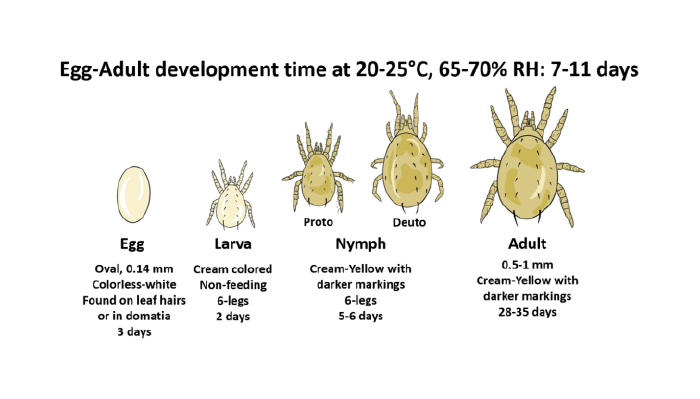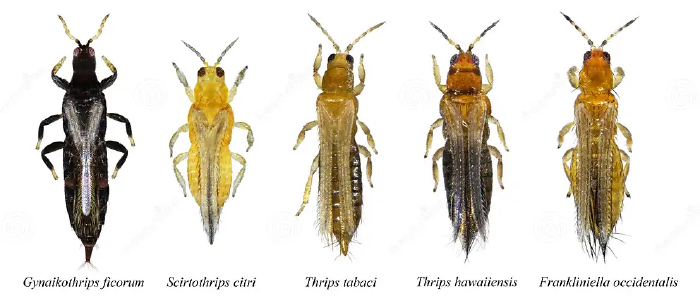Neoseiulus cucumeris a biological agent against thrips and mites

Neoseiulus cucumeris is a generalist predator used as a biological agent showing a remarkable efficiency in controlling various species of thrips and mites on greenhouse ornamental and horticultural crops. They are reliable alternatives to synthetic chemicals and can be applied both as a preventative and control method for managing pests.
Presentation
Neoseiulus cucumeris is a predatory mite from the Phytoseiidae A cucumeris family. It's considered one of the top produced and released biocontrol agents in the world. It was first used commercially in 1985 for thrips control in Europe and is now naturalized in many parts of the world. It is currently primarily used for thrips control, although it will eat other pests like psyllids, whiteflies, and plant-feeding mites. The predatory mite is active and very voracious in its search for prey.
Neoseiulus cucumeris will often feed on the most abundant and available prey and will prefer prey eggs and immatures that are less active but nevertheless, they also feed on spider mites.
Life stages
The adults lay eggs which hatch into super small larvae which then develop into nymphal forms before reaching adulthood.
Neoseiulus cucumeris develop through one larval stage and two nymphal stages (protonymph and deutonymph) before becoming adults. The life cycle from egg to adult may be completed in 9 to 12 days at 25°C and adults may live up to 28–35 days. An adult female produces an average of 35 eggs during her lifetime(Cloyd, 2023).

Neoseiulus Cucumeris appearance
Neoseiulus spp. are small (0.5-1.0 mm), pear-shaped, and cream-yellow colored. With a size of 0.5 mm the predatory mite is difficult to see with the naked eye and can be best seen with a hand lens of at least 10× magnification or under a stereoscope.
Neoseiulus cucumeris as preventative biocontrol agent
Besides the prey, the predatory mite feeds itself with pollen and anther dust. This has the advantage that the cucumeris can survive reasonably well without prey. It is therefore recommended to apply N. cucumeris as a preventive control for thrips and/or plant-feeding mites when non-prey resources are available.
Pest species controlled by cucumeris
- The western flower thrips (Frankliniella occidentalis)
- Onion thrips (thrips tabaci)
- Greenhouse thrips (Heliothrips haemorrhoidalis)
- Melon thrips (thrips palmi)
- Cyclamen mites (phtyodromus=steneotarsonemus pallidus)
- Broad mites (Polyphagotarsenomus=Hemitarsonemus latus)
- Tomato russet mite (Aculops lycopersici)

Mode of action
Predatory mites pierce their prey with their sucking mouthparts and suck out the contents.
How to use
Multiple delivery strategies are available that include a direct release from buckets or bottles (i.e., predators released at once) and a slow release via porous sachets equipped with temporary prey.
Direct release
Buckets or bottled containers are available for direct release in field, greenhouse, and nursery operations. Both systems consist of predatory mites and bran mites (Tyrophagus putrescentiae Schrank, a temporary food source of the predatory mite) mixed with bran or vermiculite.
How to release N. cucumeris Directly in the field
- For best results, release as soon as receiving shipment.
- Gently rotate the tube to evenly mix the mites in the carrying material,
- Sprinkle on top of the plant canopy or near the base of the stem.
- Avoid pesticides (organic or synthetic) before and after release.
- Avoid top watering or washing plants after release.
Slow release

A slow release delivery system (controlled release method) is also available, where mites along with the dispersal medium and temporary food are contained in sachets (1000 mites/sachet) that can be hung on the host plants. Tiny pores within the sachets allow gradual movement of the mite nymphs onto the host plants in subsequent weeks following their application. This is a preventative strategy when pests are not present. Slow-release systems will ensure that predators do not starve or are consumed by competing predators upon release.
Where to use
Neoseiulus cucumeris can be applied on indoor and outdoor-grown plants where prey and/or non-prey plant resources (pollen and nectar) are available. Its majorly used on greenhouse ornamental crops and horticultural crops.
When to use
Timing:
- Before pest arrival (preventative) and after pest infestation (control).
- Best to release early morning or evening hours.
Release rates
- For strawberries: release at 2 liters/10,000 plants at first flower in spring and again 4-6 weeks later. Where thrips are high, a third release may be needed.
- In greenhouse crops: Cucumeris should be released at a rate of 50-200 predators/m² of cropping area (4-16 liters/ha) depending on thrips pressure.
- In crops with low thrips pressure and which have sufficient pollen such as capsicums (once flowering has started), the lower rate can be used, but should be applied in two doses 14 days apart to ensure even distribution through the crop.
- In crops with poor pollen supplies (such as cucumbers) or with higher thrips pressure, the higher rate should be applied and repeated after two weeks. In high value and susceptible crops, continue releases at higher rates every two weeks.
The best conditions for cucumeris
- The predatory mite is most active between 15°C, at temperatures around 25°C this predatory mite is best in its element.
- Above 33°C the predatory mite is not active or may not survive. It will search deeper into the crop in plant axils for a cool, humid environment to survive.
Storage and conservation
It is recommended to release the predators immediately upon arrival.
However, if storage is necessary cucumeris can be stored for 1 day at room temperature in a dark, humid place (RH 60% or more).
Avoid any contact with direct sunlight.
Neoseiulus cucumeris persists and performs best on plants that produce pollen, or when provided alternative food sources such as cattail pollen (Typha latifolia).
Formulation of commercial available cucumeris
Commercially sold predatory mites always consist of the following packed in sachets or bottles as illustrated below.

Predator: Neoseiulus cucumeris.
Carrier: Vermiculite or bran.
Food Source: Feeder mite.
Commercial availability
Neoseiulus cucumeris species is widely available by multiple distributors.
- TipTop BioControl
- Koppert
- Rincon-Vitova
- Distribuciones IMEX S.A. de C.V.
- Anatis Bioprotection
- Entomology Solutions
- Natural Insect Control
- Applied Bio-nomics
- Hydro-Gardens
- Biobest
- Syngenta Bioline
- Beneficial Insectary
- EcoSolutions
Advantages for farmers and environment
- Integrated pest management Neoseiulus cucumeris can be integrated with some of the chemical insecticides like buprofézin, flonicamid for the sustainable management of various pests.
- Ease of application there is no need for complicated equipment.
- Environmentally friendly. Considered environmentally safe with no toxicity.
- Safe to use: There is no evidence of harm to humans, plants and animals or environmental health.
- Excellent persistence in presence of alternative food source (pollen).
- Survive at low prey densities.
- Can be introduced preventatively.
Limitation to farmers
While some pesticides are not harmful to predatory mites, many are directly toxic or have sub lethal effects. These can prevent predators from establishing and/or reduce their efficacy (e.g. synthetic pyrethroids, organophosphates and neonicotinoids can have residual toxicity that affects Cucumeris for many weeks).
The market cost of available products
Market prices vary depending on the supplier, crop size, and pest infestation levels, but usually considered cost-effective when considering long-term benefits of reduced pesticide use.
For example at Biogrowi.com their prices range from 19€ (5000 mites), 32.50 € (25.000 mites) to 95€ (125.000 mites).
At Limoiland their prices range from 22 € for 20 sachets and 45€ for 50 sachets with each sachet containing 50 to 200 Cucumeris.
At Servovendi a 5 liters of Koppert brand Thripex is at 69.90€.
References
- Garima Kakkar, Vivek Kumar. (2016, July). cucumeris mite—Neoseiulus cucumeris.
- https://entnemdept.ufl.edu/creatures/BENEFICIAL/Neoseiulus_cucumeris.htm https://www.efsa.europa.eu/en/corporate/pub/pesticides-ebook-180424
- How to release CucuLiv (Neoseiulus cucumeris). (n.d.). GrowLiv Biologicals. Retrieved October 1, 2024, from https://www.growliv.com/pages/neoseiulus-cucumeris-release-instructions.
- LeBeck, L., & Leppla, N. (2015). Guidelines for Purchasing and Using Commercial Natural Enemies and Biopesticides in North America: IPM-146/IN849, rev. 8/2015. EDIS, 2015, 15. https://doi.org/10.32473/edis-in849-2015
- Samantha Willden,Rebecca Schmidt-Jeffris,Gregory Loeb. (2022, January 13). Neoseiulus cucumeris–Predatory Mite | NYSIPM
- Biocontrol Fact Sheet. https://cals.cornell.edu/new-york-state-integrated-pest-management/outreach-education/fact-sheets/neoseiulus-cucumeris-predatory-mite
- Sustainable use of pesticides—European Commission. (n.d.). Retrieved November 3, 2024, from https://food.ec.europa.eu/plants/pesticides/sustainable-use-pesticides_en

